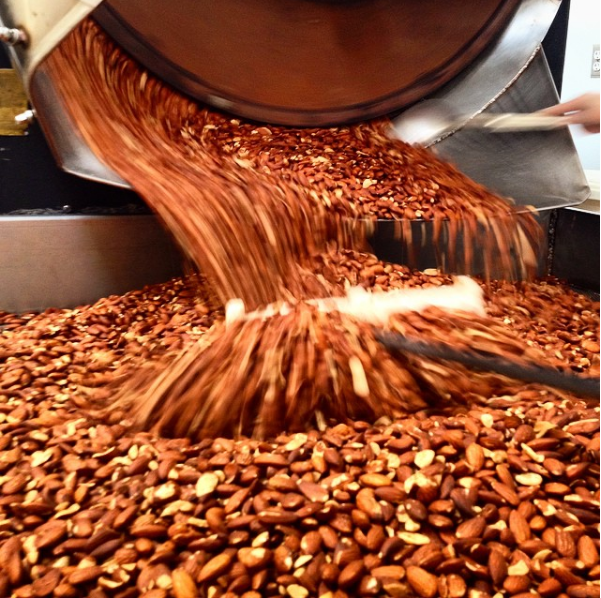For starters, roasted does not mean the same as dry roasted. Both methods require heating to a temperature between 250 and 350 degrees F, but roasting means heating with oil while dry roasting is heating without. Traditional roasting for nuts usually has the nuts floating down a long declined trough of oil. It's like they were being fried. On the other hand, dry roasting is done with industrial sized ovens or stoves. Coffee beans are a great example of dry roasting. You can roast at home using your oven or stove, with or without oil. Both methods change the flavor profile and textures. When we aren't eating raw, we prefer dry roasting since the finished product contains slightly less fat and less calories than oil roasting. Aside from that, we couldn't find any major health differences.
When it comes to raw vs roasted (or dry-roasted), studies indicate that eating raw nuts is the healthier choice. On the surface, ie nutritional facts, not that much changes between raw and roasted nuts, but that's not the case when you start looking at how heat chemically alters the nuts. The 3 main problems with roasting nuts is that the heat can damage healthy fats, cause a loss of heat sensitive nutrients, and form harmful compounds. Heat can damage polyunsaturated fats through oxidation. Polyunsaturated fats, along with monounsaturated fats, are one of the nutrients in nuts that are linked to lowering blood pressure and reducing the risk of heart disease. The more you heat the nuts, the less healthy fats you have. Studies have shown that the heating nuts at a higher temperatures for longer periods damage these fats greater than if heated at lower temperatures for a shorter period. It's interesting to note that roasted nuts can oxidize faster during storage too.
Antioxidants can get lost due to roasting. The large amount of antioxidants contained in some nuts are a huge reason why they're considered superfoods. The heating process reduces the level of antioxidants. The good news is that roasting doesn't remove all antioxidants completely and some nuts, like pistachios, aren't affected at all. In one study, the antioxidants lutein and zeaxanthin were found to have no difference in change between raw and dry-roasted pistachios. Yay for dry-roasted pistachio lovers! =)
Roasting nuts gives us a different flavor, color, and aroma but it also that same chemical reaction that changes the nuts creates a substance called acrylamide. Acrylamide is known to cause cancer in animals when consumed in high doses. Worst yet, almonds are especially prone to forming acrylamide due to their high amounts of the amino acid asparagine. As a consolation prize, roasting at higher temperatures seem to cause more acrylamide to form rather than roasting duration. So if you like dry-roasted almonds, keep the oven on low (245 degrees F)!
There's some good to roasted nuts though. Supposedly, roasted nuts are easier to absorb in our bodies so we get more nutrients into our system when we eat them roasted. Think all the good stuff on the nutrition fact labels that don't change between raw or dry-roasted nuts. And, eating raw, unpasteurized nuts can contain harmful bacteria or fungi like E.Coli or Salmonella. Both of these can cause serious illness and even death.
In the end, we suggest buying your nuts raw but pasteurized. Aside from what we just mentioned, raw nuts really let you taste the quality and freshness. A really high quality and fresh nut should have a super delicious flavor and great texture on its own. Plus! You can always choose to roast them yourself whenever you want. Just use your oven. Set the temperature to about 250 degrees F and sprinkle on any spices or flavors you'd like. You get to be creative and you can control how much salt or sugar you're adding.
Whatever you choose, keep healthy, eat delicious foods, and enjoy!
More to Read for the Curious:
- https://www.healthline.com/nutrition/raw-vs-roasted-nuts#section4
- https://www.livestrong.com/article/349980-raw-almonds-vs-roasted-almonds/
- https://www.livestrong.com/article/489676-what-is-healthier-dry-roasted-or-regular-peanuts/
- https://longevitypt.com/almonds-natural-blanched-roasted/
- https://www.johnnyfit.com/nutrition/i-think-theyre-nuts-raw-almonds-vs-dry-roasted-almonds.html/

